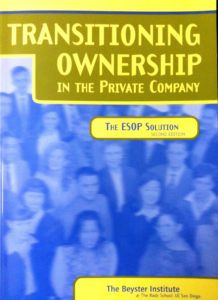So what’s it Like Living with an ESOP?
Readers of my posts on ESOPs (employee stock ownership plans) know that an ESOP offers a very attractive path for cashing in some (or all) of a business owner’s company stock – and that much of the attractiveness is driven by big tax advantages. But implementing an ESOP also means that the stock you sell will end up in the retirement savings accounts of the company’s employees. Is this something a business owner might live to regret?
An important question that often comes up in these discussions is the issue of corporate control. After all, the employees have the stock. Could they become disruptive? Inmates running the asylum?
The answer, in a word, is no.
More than 25,000 ESOPs have been established since they were first authorized by law in 1975. And none of them resulted in a mutiny. There is a simple reason for this. The employees who participate in an ESOP don’t control the voting of the stock in their retirement accounts. Stock in an ESOP is actually held for the employees in a trust. And the trust (and its contents) is controlled by a trustee. The trustee may be an institution (like a bank) or a professional individual, or a group composed of company managers. But in all cases, appointment as a trustee is made by the company board of directors. So the board is in charge at an ESOP company, just as it is at any other corporation. The rules of corporate governance don’t change.
What employees do have when they participate in an ESOP is a financial stake in the ongoing success of the business. At that’s where good things begin. The motivational power of an ESOP is strong, and its impact profound. Done right, employees become a well-coordinated, proactive team, with all their eyes on the same prize. They want to see the firm prosper. Why? Because 1) they want to get richer; and 2) they want their team to win! Well-run ESOP companies develop the feel of a sports team, where all the players know what the objective is, and what needs to be done to achieve it. And when they score, there’s a lot of high-fiving all around.
People in senior management tell me that, ultimately, what they like best about having employees participate in stock ownership is that running the company is easier – and more fun. Employees at these companies understand why it’s important to keep expenses down, why we need to be super-nice to our customers, why we need to be on the lookout at all times for new sales opportunities. Managers tell me that when things go well, it’s good to have more people to high-five with. And when things get rough, it helps knowing that others are losing sleep too.
Is there anything beyond a few general anecdotes to substantiate the notion that employees respond to stock ownership with better performance? In fact, a series of rigorous academic studies have been completed on this question. And the body of evidence showing that companies get a performance boost is pretty conclusive. You’ll find a good summary of this research at https://www.nceo.org/articles/studies-employee-ownership-corporate-performance.
Living with an ESOP – it’s a good experience.
Next week’s topic: ESOPs in Action: a Typical Example
___________________________________________________________________________________________________
Martin Staubus is with the Beyster Institute (part of the Rady School of Management at UC San Diego) where he advises company leaders on the effective deployment of ESOPs and other stock plans. The Institute was established by entrepreneur Bob Beyster, who founded SAIC, a Fortune 500 company. https://www.rady.ucsd.edu/beyster/
Category: Business Growth & Strategy
Tags: business succession, ESOP, exit planning, tax on sale

 Share
Share